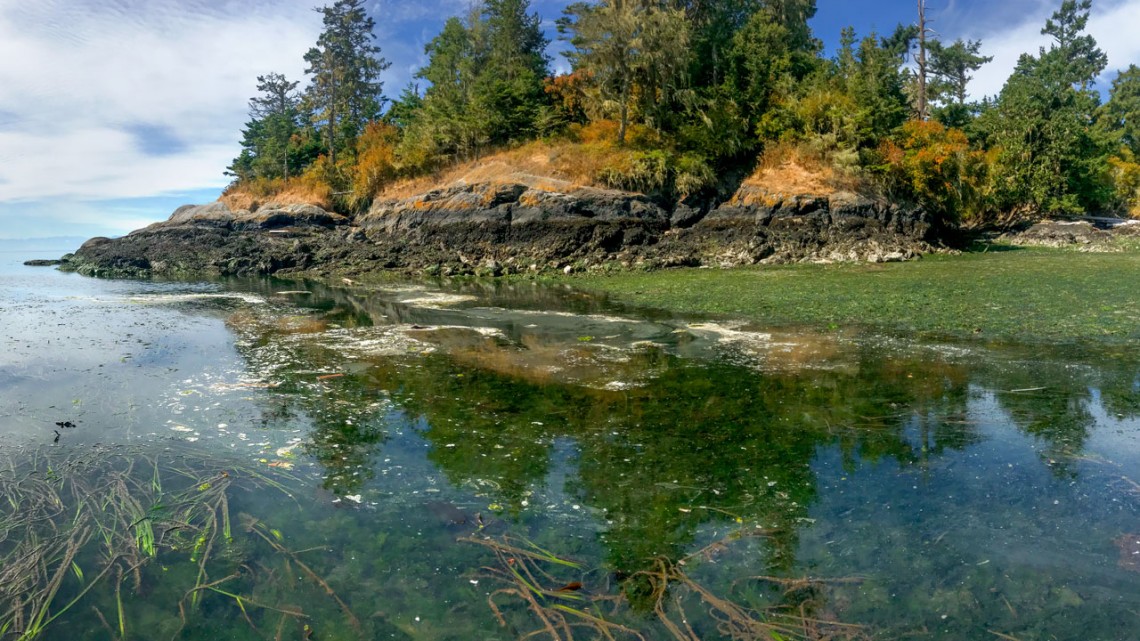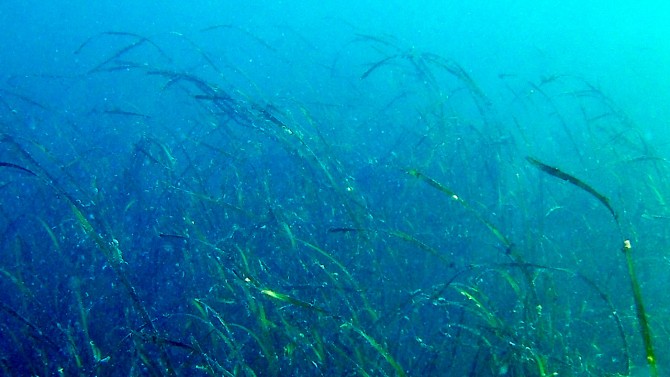
On a low tide, the intertidal eelgrass meadow at False Bay Biological Preserve, Washington, becomes visible. This meadow is home to many invertebrates and fish, including flatfish, perch and gunnels.
Doctoral student contributes to global ocean-predator study
By Blaine Friedlander
Cornell doctoral candidate Olivia Graham joined five-dozen scientists on four continents to create a marine biology first: a global “BiteMap” to show, in a climate-changing world, where the ocean’s mid-sized predators are most active.
The multiyear study showed how – as persistent global warming heats the oceans – rising temperatures can reconfigure entire communities of marine predators and impact creatures lower on the food chain.
The study was led by the Marine Global Earth Observatory, part of the Smithsonian Environmental Research Center on the Chesapeake Bay, in Edgewater, Maryland. The work was published Oct. 26 in the Proceedings of the National Academy of Sciences.
The researchers examined predation around the world in seagrass meadows close to shore, said Graham, who did her research from the cool, shallow waters of the San Juan Islands in Washington.
“This was the first paper of its size and scope to grapple with the fish-community effects of global warming and map predation inside and outside of seagrass meadows,” she said.
In her regular graduate research, Graham explores the ocean’s abiotic conditions, potential disease vectors and microbiomes, as she examines seagrass wasting disease (Labyrinthula zosterae) in the Pacific Northwest. She’s a member of the laboratory of Drew Harvell, professor of ecology and evolutionary biology in the College of Agriculture and Life Sciences.
Four years ago, Harvell asked Graham – then a new graduate student – to participate in this global project from False Bay, in Friday Harbor, Washington – Graham’s hometown.
At timed intervals, Graham created a large underwater field of dried squid attached to 3-foot-high sticks, designed to lure the predatory fish and crabs in for an easy meal. Then, the researchers would catch the visitors by net and count them.
In general, the global researcher group saw the least feeding activity in the colder climes and at the equator, according to the paper. Going into the study, the scientists thought that feeding and predation activity would be greatest at the equator, but found that predation peaked in the subtropics, between 25 degrees and 35 degrees latitude in both hemispheres.
“Seagrass meadows are rich biodiversity habitats globally,” Graham said, “and this study showed a way to map how ecological function varies with biodiversity across a wide latitude.”
Emmett Duffy, director of the Marine Global Earth Observatory and Ross Whippo, marine ecologist at the University of Oregon, organized the project. Lead author Matt Whalen, a MarineGEO postdoctoral scholar at the Hakai Institute in British Columbia, Canada, analyzed the project’s data.
The research was funded by the Smithsonian Institution and the Tula Foundation.
Media Contact
Get Cornell news delivered right to your inbox.
Subscribe

